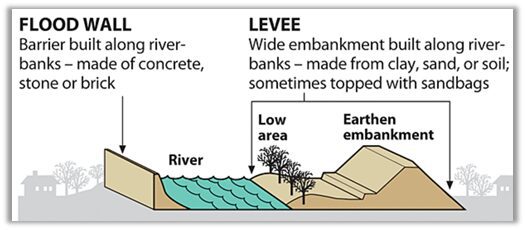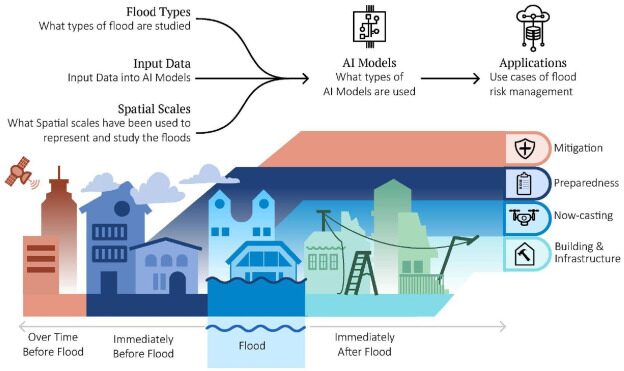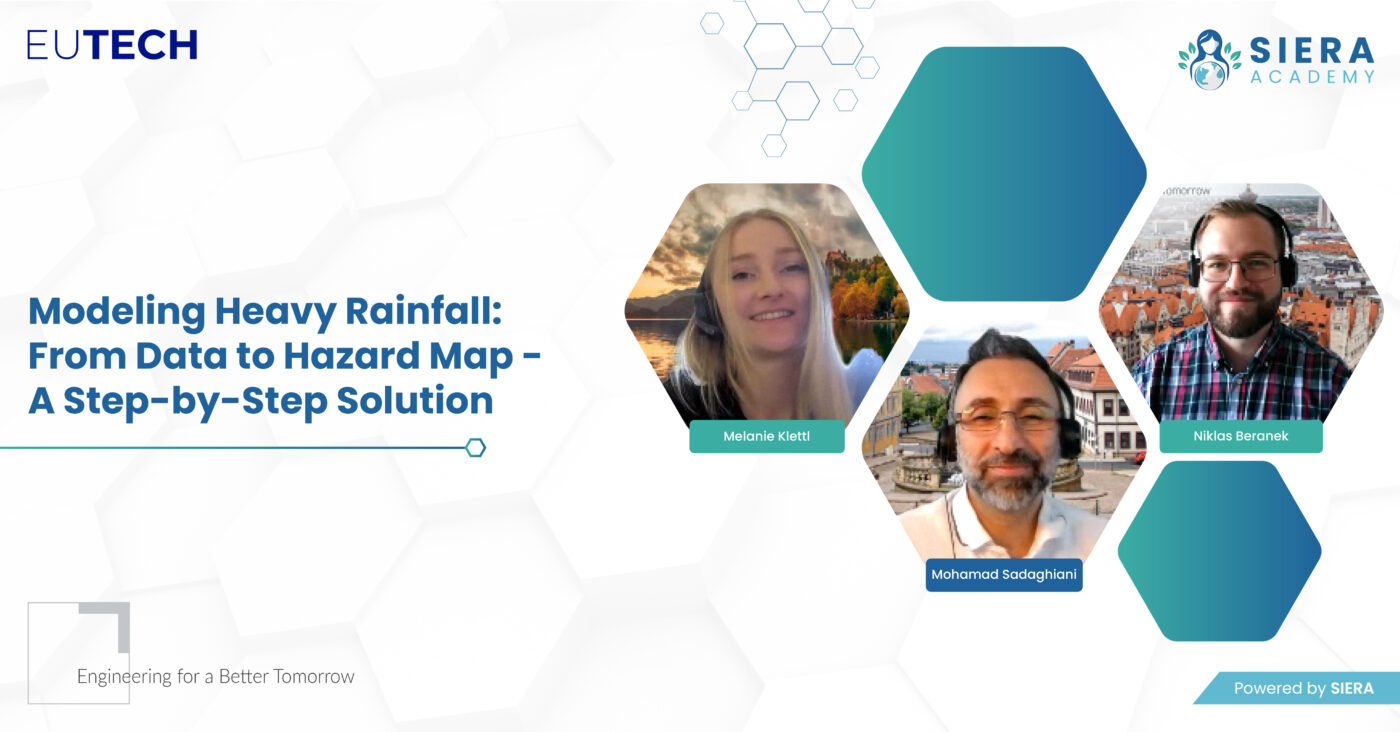On June 17, 2025, Impact Series webinar hosted by SIERA Academy, organized a pivotal webinar titled “Modeling Heavy Rainfall: From Data to Hazard Map – A Step-by-Step Solution.” With floods becoming more frequent, intense, and damaging due to climate change, this event addressed one of the most urgent climate adaptation needs facing European municipalities and infrastructure providers: how to transform complex rainfall data into actionable flood risk intelligence.
The session brought together expert hydrologists, regulatory specialists, and environmental engineers to examine not only the challenges of climate-driven flooding, but also the technical and regulatory tools available to mitigate its impact. It introduced participants to hydrological modeling techniques, GIS-based flood hazard mapping, and the crucial role of digital compliance platforms like SustainSuite – part of SIERA in aligning local flood protection strategies with the European Sustainability Reporting Standards (ESRS).
Set against the backdrop of rising flood damages across the continent—with over €170 billion in economic losses since 1980—the webinar made it clear: climate-resilient flood management is no longer a reactive response but a proactive, data-driven obligation for anyone involved in urban planning, environmental compliance, or infrastructure investment.
In this blog, we explore the major insights shared during the session—from risks and regulations to real-world modeling solutions and opportunities. You’ll discover how data-driven flood management can reduce damage, unlock EU funding, and align with new compliance standards—while building safer cities for a changing climate.
Challenges – Risks Arising from Flooding and Climate Change
Flooding has become one of the most expensive and disruptive consequences of climate change. As highlighted during the webinar, over 300 major flood events affected Europe between 1980 and 2022, incurring more than €170 billion in economic damages. Yet this number only tells part of the story. Behind every figure lies the growing failure of existing infrastructure, risk management tools, and regulatory responses to cope with intensifying extreme weather patterns—most notably, heavy rainfall events that result in flash floods and widespread urban inundation.

Source: https://levees.sec.usace.army.mil/flood-basics/about-flooding/
One of the core challenges discussed was the growing frequency and severity of these rainfall-induced floods. Unlike riverine or coastal flooding, pluvial flooding from localized, intense rainstorms can occur almost anywhere, often with little warning. These events are exacerbated by urbanization, which replaces permeable natural surfaces with concrete and asphalt, dramatically increasing surface runoff. In many EU cities, existing drainage and stormwater systems were not built to withstand the current scale of rainfall events, let alone those projected under future climate scenarios.
Beyond physical damage, the webinar also explored the operational and financial consequences of flooding on businesses and municipalities. Floods disrupt supply chains, damage inventory, and cause long-term shutdowns of critical infrastructure. One striking example shared was a logistics company in Germany that suffered a credit rating downgrade in 2021 due to its inadequate flood protection strategy—resulting in a 15% increase in borrowing costs. Similarly, the city of Venice incurred €5 billion in damages during the 2019 floods, underlining how the cost of inaction can far exceed the cost of resilience investments.
Insurance markets are also responding. Escalating premiums and tighter coverage restrictions reflect how insurers now price in the lack of proactive flood mitigation planning. As environmental risks grow more visible, regulatory penalties and investor scrutiny intensify. Companies that fail to demonstrate flood resilience increasingly face regulatory non-compliance, deteriorating ESG ratings, and erosion of stakeholder trust.
Perhaps most concerning, the session revealed that only 40% of EU municipalities have adequate flood hazard maps or early warning systems in place. This lack of basic preparedness leaves vast areas—and millions of residents—exposed to severe flooding with no strategic defense. Without immediate action to close this data and planning gap, the future will bring not just more frequent floods—but more avoidable disasters.
Regulatory Implications in the EU for Flood Protection & Climate Resilience
While the risks of flooding are growing, so too is the regulatory pressure to act. The webinar provided a comprehensive overview of the European Union’s legislative framework for flood risk reduction—particularly under the lens of compliance, disclosure, and environmental responsibility.
Flood protection is now directly intertwined with CSRD (Corporate Sustainability Reporting Directive) and the new European Sustainability Reporting Standards (ESRS). Municipalities and companies alike must report their climate adaptation strategies, pollution mitigation, and resilience to water-related risks.
Key EU Regulations Impacting Flood Resilience
| Regulation / Directive | Purpose and Impact |
| EU Floods Directive (2007/60/EC) | Requires Member States to assess flood risks, create hazard maps, and establish Flood Risk Management Plans. |
| Water Framework Directive (2000/60/EC) | Mandates the protection of water quality in all flood-related infrastructure. |
| EU Taxonomy Regulation (2020/852) | Classifies flood protection projects as sustainable if they meet environmental screening and DNSH criteria. |
| Environmental Liability Directive (2004/35/EC) | Holds stakeholders financially accountable for flood-induced environmental damage. |
| Strategic Environmental Assessment Directive (2001/42/EC) | Requires climate risk evaluations in public planning and zoning policies. |
These directives work in tandem to ensure that resilience is built into policy, infrastructure, and finance. Flood protection is no longer a stand-alone safety measure—it is a legal expectation, and in many sectors, a prerequisite for investment.
Opportunities from Flood Protection Infrastructure
Flooding is not only a rising threat—it’s a transformative opportunity. As the webinar emphasized, the growing frequency of extreme weather has created fertile ground for innovation in engineering, environmental design, digital compliance, and finance. When implemented with foresight, flood protection infrastructure can yield operational, economic, and ESG advantages far beyond disaster mitigation alone.
Rather than viewing compliance as a constraint, the session reframed it as a strategic pathway—one that opens doors to public funding, improves stakeholder confidence, and enhances an organization’s long-term sustainability profile.
Turning Risk into Resilience: 4 Opportunity Pillars
1. Strengthening ESG Ratings and Compliance
Flood resilience measures—when documented and verified—help organizations align with EU Taxonomy and CSRD standards. This enhances transparency and elevates ESG scores, which are now closely monitored by investors, insurers, and regulators. Better ESG ratings directly improve access to green financing, credit incentives, and long-term capital.
2. Reducing Insurance Premiums and Improving Financial Stability
By investing in data-driven flood protection systems and hazard maps, companies and municipalities can demonstrate reduced exposure to physical climate risks. This often translates to lower premiums and improved insurability. Over time, it also buffers financial volatility during extreme weather events.
3. Building Supply Chain Resilience and Business Continuity
Floods disrupt transport routes, delay logistics, and compromise infrastructure. Protecting assets from inundation is no longer just a safety measure—it’s a business continuity strategy. Ensuring operational uptime enhances competitive positioning, protects jobs, and safeguards reputational value.
4. Unlocking Public and Private Funding Channels
Flood protection projects aligned with climate goals are now eligible under a growing suite of EU programs such as the Innovation Fund, LIFE programme, and the Just Transition Mechanism. Whether through municipal partnerships or corporate investment frameworks, well-designed projects increasingly attract subsidies, grants, and blended finance.
Flood Protection Strategies and Resilience Solutions
To effectively respond to the challenges posed by extreme rainfall and urban flooding, it is no longer sufficient to rely on outdated infrastructure or isolated emergency responses. The SIERA Academy webinar emphasized the importance of a comprehensive and integrated approach—one that combines engineering innovation, technological modeling, ecosystem-based solutions, and regulatory alignment.
The session presented five critical strategy areas that demonstrate how municipalities and companies can proactively strengthen their climate resilience.
1. Infrastructure Solutions: Strengthening Physical Defenses
At the foundation of flood protection lie hard engineering interventions. These include upgraded drainage systems, retention basins, elevated structures, reinforced levees, and urban water storage installations. Such physical defenses are critical for preventing immediate damage during high-intensity rainfall events.
Well-designed infrastructure anticipates future climate stressors and integrates redundancies to prevent system failure. The emphasis is no longer only on containment—but also on absorption, delay, and redirection of floodwaters in urban and industrial zones.

Image: Methods of Flood Control
https://www.csmonitor.com/USA/2008/0620/p01s03-usgn.html
2. Technology-Driven Approaches: Leveraging Data and Simulation
The use of simulation tools such as InfoWorks ICM has become a game-changer in flood modeling. The platform enables detailed 1D/2D hydrodynamic analysis that replicates surface runoff, sewer system behavior, and rainfall event impacts.
Participants learned how data from weather stations, digital terrain models, and on-site inspections can be fed into these systems to build high-resolution flood models. This includes calibrating results using historical flood data—such as the 2021 rainfall event in Cologne—and generating precise visualizations of flow paths, accumulation zones, and risk hotspots.
These simulations not only inform infrastructure upgrades but are now considered essential for risk disclosure under EU Taxonomy.

Image: Artificial Intelligence for Flood Risk Management
(https://www.sciencedirect.com/science/article/pii/S2212420924008720)
3. Nature-Based Solutions: Harnessing Ecosystem Services
Beyond engineered infrastructure, nature itself offers effective and scalable flood mitigation options. Nature-based solutions—such as green roofs, urban wetlands, rain gardens, and bioswales—reduce runoff, improve infiltration, and enhance environmental resilience.
These systems are particularly valuable in urban settings, where sealed surfaces exacerbate flooding. Incorporating natural systems into urban planning can mitigate peak loads on drainage networks, while simultaneously delivering benefits for biodiversity, air quality, and public health.
4. Financial and Regulatory Strategies: Aligning with Compliance and Funding
Flood protection is increasingly tied to financial sustainability and policy compliance. The session examined how alignment with standards such as DWA M-119, DIN EN 752, and the EU Taxonomy Regulation enables municipalities and developers to qualify for dedicated climate adaptation funding.
These frameworks encourage integrated planning, transparent cost justification, and measurable environmental performance—making it easier to secure support from the Innovation Fund, LIFE programme, and national adaptation grants.
Proper documentation, risk assessment, and reporting also help reduce insurance costs and attract responsible investment.
5. Digital Compliance and Monitoring: SustainSuite – Part of SIERA
Finally, the webinar introduced participants to SustainSuite – part of SIERA, a digital platform that supports real-time compliance, monitoring, and reporting.
Key functionalities include:
- Automated Compliance Tracking
Aligns infrastructure efforts with ESRS E1 to E5 indicators and regulatory mandates. - Real-Time Impact Monitoring
Integrates IoT and geospatial analytics to measure environmental and social performance. - AI-Powered ESG Reporting
Generates high-accuracy reports for stakeholders, regulatory bodies, and investors.
By embedding these tools into the lifecycle of infrastructure projects, cities and companies can demonstrate that flood protection is not only operationally necessary—but also strategically valuable and finance-ready.
Case Studies
The highlight of the webinar was a detailed, data-rich case study was presented. The case study showcased a step-by-step flood hazard analysis in Frechen, a municipality near Cologne, Germany. Using advanced modeling techniques and regulatory frameworks, this project provided a practical demonstration of how cities can assess, visualize, and mitigate heavy rainfall risks.
Flood Hazard Analysis in Frechen: From Concept to Simulation
The primary objective of the study was to conduct a comprehensive heavy rainfall hazard analysis using the hydrodynamic modeling platform InfoWorks ICM. The analysis was motivated by increasing flood risks in the region, and the absence of legally required hazard maps for heavy rain events—still a gap in much of Germany.
Phase 1: Data Collection and Preparation
A successful flood model begins with rigorous data acquisition. For Frechen, the following datasets were compiled:
- Digital Terrain Models (DTM1) with 1-meter resolution
- Orthophotos, ALKIS/ATKIS land use data, and environmental zoning data
- Station-based precipitation data from Cologne-Stammheim during the 2021 flood
- Site inspection photos, land use attributes, and existing hazard maps from the BKG (Federal Agency for Cartography and Geodesy)
This comprehensive data set allowed the team to begin simulation modeling at a fine-grained scale.
Phase 2: Modeling Methodology
The modeling process incorporated both 1D and 2D hydrodynamic simulations—though in this project, surface runoff was analyzed using a fully 2D approach. Key elements of the methodology included:
- Simulation of block rainfall events (e.g. 60-minute, 100-year return period)
- Mesh generation with approximately 320,000 computational cells
- Differentiated land use and surface roughness based on local conditions
- Flow path analysis across a defined 330-hectare catchment area
The surface flow modeling allowed visualization of runoff patterns, accumulation zones, and water levels across various topographies—validated through real-world observations and local knowledge.
Phase 3: Validation and Results
Model results were cross-referenced with official hazard maps from BKG. The outcome showed strong statistical agreement between simulated data and mapped flood patterns. Key observations included:
- Highest flood depths occurred in the eastern section due to overlapping surface runoff
- Consistent discharge concentration in both northern and southern zones
- Model validation confirmed the reliability of flow path prediction and depth modeling
This level of agreement established the model’s accuracy, making it suitable for both regulatory reporting and infrastructure planning.
Lessons for Broader Application
The Frechen case illustrates the potential of advanced simulation tools to produce legally and technically robust flood hazard maps—even in areas without prior data. It also demonstrated how modeling results can be used to inform risk communication, spatial planning, and investment in protective infrastructure.
While the case study focused on a specific municipality, the methods, standards, and tools applied are replicable across Europe—particularly in areas seeking to meet regulatory requirements or align with the EU Floods Directive.
Take the Next Step with SIERA
The webinar concluded with a clear message: effective flood protection is no longer just a technical necessity — it is a regulatory requirement, a business priority, and a strategic advantage. In the face of increasingly volatile weather patterns, forward-looking municipalities, infrastructure developers, and utility providers must embed climate resilience into their operations, planning processes, and reporting systems.
This is where SIERA Alliance plays a vital role.
With decades of expertise in environmental engineering and regulatory alignment, SIERA helps stakeholders turn vulnerability into preparedness — and compliance into opportunity. Through advanced tools like SustainSuite, SIERA equips decision-makers with the intelligence, documentation, and digital platforms needed to meet the demands of today’s flood risks and tomorrow’s sustainability standards.
SIERA Services for Flood Protection and Compliance
1. Flood Risk Mapping and Heavy Rainfall Modeling
Using high-resolution digital terrain models, localized precipitation data, and simulation tools like InfoWorks ICM, we produce actionable flood hazard analyses that support planning, compliance, and community engagement.
2. Regulatory and ESG Alignment
We ensure your flood protection strategies align with the EU Floods Directive, Water Framework Directive, EU Taxonomy Regulation, and ESRS (E1 to E5) — helping you meet both public and private reporting requirements.
3. Digital Compliance with SustainSuite – part of SIERA
SustainSuite allows municipalities and companies to track flood-related risks in real time, monitor environmental and social impacts, and generate regulatory-compliant reports with AI-powered accuracy.
4. Nature-Based Infrastructure Design
We integrate green and blue infrastructure into your master planning — from bioswales and retention areas to smart infiltration systems — helping you meet resilience targets while restoring ecosystem function.
5. Funding and Financing Support
Through guidance on national and EU-level climate funding instruments, we help projects become investment-ready — from proposal to implementation.
Engineering for a Better Tomorrow
Get in touch with SIERA Alliance to discover how your region or infrastructure project can unlock the full value of climate-resilient flood protection. Whether you’re modeling extreme rainfall events, creating hazard maps, or integrating nature-based systems into urban drainage networks, we deliver the tools and knowledge to turn your strategy into measurable climate action.
“We won’t solve tomorrow’s floods with yesterday’s thinking. We need to work with nature — not against it — to shape a resilient future.”
— Dr. M. Reza Salehi Sadaghiani







